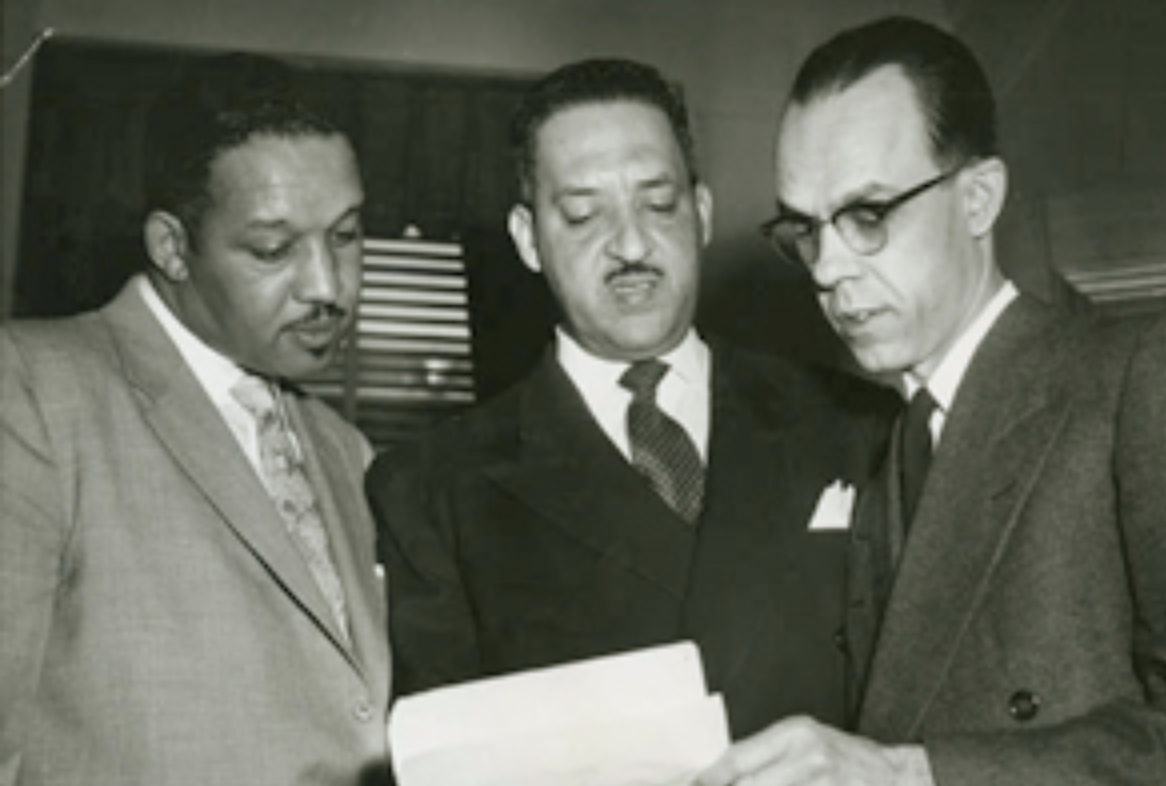The National Association for the Advancement of Colored People (NAACP) and its legal offspring, the Legal Defense and Educational Fund, developed a systematic attack against the doctrine of “separate but equal.” Three lawyers confer at the Supreme Court, 1953. Gelatin silver print. New York World-Telegram & Sun Collection, Prints and Photographs Division, Library of Congress
By Mary Sanchez
Tribune Content Agency
No, Black children do not need a white child seated next to them to learn.
This offensive contention wasn’t true 70 years ago when the U.S. Supreme Court ruled in the historic Brown v. Topeka Board of Education case.
And it’s not true today. Not even as hyper-segregated – predominantly Black and Latino schools – are increasing across America.
Yet this fallacy, a misunderstanding of the legal underpinnings of the historic Brown decision, remains common. If people would think about it a bit more, they’d likely walk back from it.
Strains of this misstep will be heard in the coming days, as the nation marks the 70th anniversary of the May 1954 decision.
Brown v. Board said nothing about the inherent intelligence of children of different races, as some critics twist themselves to imply. To do so, would be to buy into loony ideas around racial dominance, eugenics, and white superiority.
The unanimous ruling, authored by Justice Earl Warren, never put forward such a contention.
Part of the problem is that discussions of the decision have become fraught with pitfalls, muddied in recent years, where any mention of efforts around equality of race have become quickly twisted into negatives. Cue the put downs of DEI and “wokeness.”
A sub-head on a recent Wall Street Journal column read: “Segregation is wrong, but Black students don’t need to share a classroom with white ones to learn.”
The piece was a critique of the approach the justices took in reaching Brown, relying on social science at the time as opposed to simply ruling against legalized segregation outright, trouncing as unconstitutional the previous standing of Plessy v. Ferguson (1896).
Fair enough.
But the article cherry picked, citing the example of an all-Black high school from the era of Brown and the stellar scholarship attainments of its students.
That’s a bit of a dodge. The ruling measured realities about public education quality across the U.S.
A few schools that showed stellar achievement despite existing in the era of legal segregation didn’t reflect all aspects of what was true then for the majority of American students.
The court considered cases from multiple states; Kansas was simply listed first in the ruling. But cases from schools in South Carolina, Virginia and Delaware were also studied. The ruling looked beyond instances where the “tangible” elements of schools, things like buildings, curricula, qualifications and salaries of teachers, had been equalized or the attempt had been made to do so.
Rather, the court wanted to look deeper into inequities, accounting for how legally segregated schools implied inferiority of Black students and the impact that had on their motivation to learn.
The original decision read: “We must look instead to the effect of segregation itself on public education.” And that focus led to the famous ruling of Brown: “Separate educational facilities are inherently unequal.”
This deprived Black children of equal protection under the 14th Amendment, the Warren court found.
In 2024, the nation is witnessing a re-segregation of Black and Latino students, a fact that could reapply what Brown found: an inherent state of inequality.
Four out of 10 Black and Latino students attend schools where nearly each of their peers is also a student of color, according to the Associated Press.
Race is tied to class in America.
As a nation, we have deeply entwined funding for public education to property taxes, to a community’s willingness to spend money on education. With this in mind, the disparate educational outcomes shouldn’t be surprising at all.
But in general, property taxes fund much of public education (K-12) across America, with state, and to a lesser degree, federal funding, making up the rest.
Wealthier districts, often created and protected by boundaries intended to rein in their affluence, are able to provide more opportunities for their students. Of course, they flourish.
What the critics are running intellectual circles to avoid is a basic truth about education in America.
Race still matters. It matters because racism through the decades has created school districts and neighborhoods that are substantially less affluent than others – generally suburban, less diverse districts.
And that fact still does tend to matter in educational outcomes. It’s about opportunity.
But it’s not because children are born any less intelligent in one part of a city as compared to another.
Our challenge is to revisit the promise of Brown, to find new ways to bring equally strong public schools to all children.
Admitting that race matters would be a start.
Readers can reach Mary Sanchez at msanchezcolumn@gmail.com and follow her on Twitter @msanchezcolumn.
©2024 Mary Sanchez. Distributed by Tribune Content Agency, LLC.




